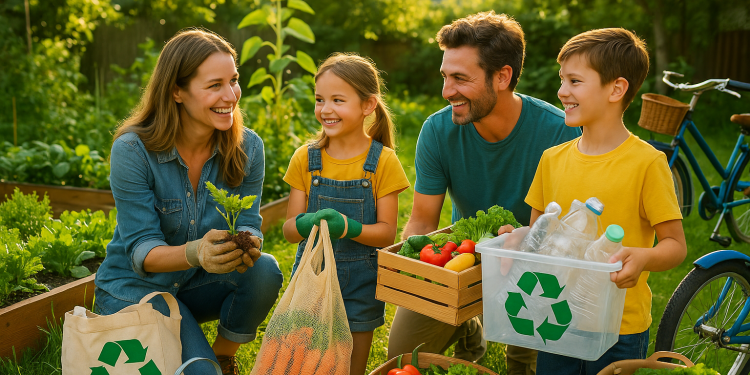Introduction: Why Sustainable Living Matters for American Families
Climate change, pollution, and resource depletion are issues that affect every family in the USA—and around the world. The good news? You don’t have to be a zero-waste expert or give up all of life’s comforts to make a difference. With a few practical eco-friendly habits, American families can live healthier, save money, and protect the planet for future generations.
This guide is your roadmap to a sustainable lifestyle: easy-to-follow, realistic, and focused on green living that fits the needs and routines of modern families.
1. Understanding Sustainable Lifestyle: What Does It Mean?
A sustainable lifestyle means making choices that minimize harm to the environment and support a healthy future for all. For American families, this could include:
- Reducing waste
- Saving energy and water
- Choosing earth-friendly products
- Supporting sustainable food systems
- Raising environmentally conscious children
Eco-friendly living isn’t about perfection—it’s about making steady, positive changes.
2. Reduce, Reuse, Recycle: The Family Approach
Start with Less
- Buy only what you need.
- Choose products with minimal or recyclable packaging.
- Opt for durable, long-lasting items rather than disposables.
Reuse Creatively
- Use reusable shopping bags, water bottles, and lunch containers.
- Upcycle glass jars for storage or crafts.
- Pass down clothes, toys, and books instead of always buying new.
Master Recycling
- Know what’s recyclable in your community—rules differ across the USA!
- Rinse recyclables and keep them clean to avoid contaminating the stream.
- Compost food scraps to reduce landfill waste and create free fertilizer.
3. Eco-Friendly Habits at Home
Energy Efficiency
- Switch to LED bulbs and energy-efficient appliances.
- Unplug electronics when not in use, or use smart power strips.
- Set your thermostat a few degrees lower in winter and higher in summer.
Water Conservation
- Fix leaks promptly—one drip can waste gallons daily.
- Install low-flow showerheads and toilets.
- Water the garden early or late to reduce evaporation.
Greener Cleaning
- Choose natural cleaners (like vinegar, baking soda, and lemon).
- Avoid products with harsh chemicals or artificial fragrances.
- Try reusable cleaning cloths instead of paper towels.
4. Green Living in the Kitchen
Smart Food Choices
- Buy local and seasonal produce to reduce transportation emissions.
- Choose organic and non-GMO foods when possible.
- Reduce meat consumption—try “Meatless Mondays” or plant-based recipes.
Waste Less Food
- Plan meals and use a shopping list to avoid overbuying.
- Store leftovers properly and get creative with recipes to use them up.
- Compost fruit and vegetable scraps.
Eco-Friendly Cooking
- Use energy-efficient appliances (like slow cookers and toaster ovens).
- Cover pots while cooking to save energy.
- Avoid single-use plastics: opt for beeswax wraps, glass containers, and bulk goods.
5. Sustainable Transportation
- Walk, bike, or use public transit whenever possible.
- Carpool or rideshare to cut emissions and costs.
- Consider hybrid or electric vehicles if buying a new car.
- Combine errands into one trip to save time and fuel.
6. Eco-Friendly Family Activities
- Spend time outdoors hiking, biking, or visiting local parks.
- Start a family garden—growing your own food is rewarding and educational.
- Organize clean-up days in your neighborhood or local park.
- Try DIY upcycling crafts or nature-based art projects.
7. Green Living for Kids: Raising Eco-Conscious Children
- Teach kids about recycling and composting with fun, hands-on activities.
- Read books and watch shows focused on nature and sustainability.
- Encourage them to care for plants or pets to build respect for living things.
- Let children help with energy-saving habits (turning off lights, conserving water).
8. Sustainable Shopping and Clothing
Buy Less, Choose Well
- Opt for quality clothing and shoes that last.
- Support ethical brands that use organic, recycled, or upcycled materials.
Secondhand First
- Thrift stores, consignment shops, and online resale sites offer great finds.
- Organize clothing swaps with friends and neighbors.
Care and Repair
- Wash clothes in cold water and hang-dry when possible.
- Repair, patch, or repurpose clothing instead of tossing it.
9. Gardening for Sustainability
- Plant native species that require less water and support local wildlife.
- Grow vegetables, herbs, or even fruit in containers if space is limited.
- Compost at home for healthier soil and less landfill waste.
- Avoid chemical pesticides—use natural alternatives like neem oil or introduce beneficial insects.
10. Community and Advocacy
- Join or support local environmental groups or sustainability initiatives.
- Advocate for greener policies at your child’s school, workplace, or city.
- Share your eco-friendly journey on social media to inspire others.
11. Table: Quick Eco-Friendly Tips for Busy American Families
| Tip | Why It Works | Simple How-To |
|---|---|---|
| Use reusable bags and bottles | Reduces plastic waste | Keep them in your car/bag |
| Compost food scraps | Less landfill, free fertilizer | Set up a bin in the kitchen |
| Buy local, seasonal produce | Cuts emissions, supports farmers | Visit farmers’ markets |
| Unplug devices when not in use | Saves energy and money | Power strips for easy shut-off |
| Try meatless meals weekly | Lowers carbon footprint | Explore plant-based recipes |
| Walk or bike short trips | Improves health, cuts pollution | Choose nearby errands |
| Upcycle or donate old items | Reduces landfill, helps others | Host a swap or donate locally |
| Use natural cleaning products | Safer for family and planet | DIY cleaners: vinegar, baking soda |
| Grow your own herbs or veggies | Fresh food, less packaging | Small pots on a windowsill |
| Teach kids eco-habits early | Builds lifelong sustainability | Make it fun—games and rewards |
12. Overcoming Challenges: Eco-Friendly Living in a Busy World
Time
- Start with one new habit at a time; build up gradually.
- Involve the whole family for shared responsibility.
Cost
- Many sustainable swaps save money in the long run (like reusable items).
- Look for free or low-cost community resources and events.
Convenience
- Plan ahead—keep bags and containers handy for shopping or outings.
- Batch errands or tasks to reduce trips and waste.
13. The Future of Family Sustainability in the USA
Sustainability is no longer just a trend; it’s a movement shaping how American families live, shop, travel, and raise children.
Advances in technology, growing awareness, and community action are making eco-friendly living more accessible than ever. As more families adopt environmentally friendly habits, the ripple effect can be huge—creating cleaner neighborhoods, healthier communities, and a brighter future for all.
Conclusion: Every Family Can Make a Difference
Living a sustainable lifestyle isn’t about perfection—it’s about making better choices, one day at a time. By adopting even a few eco-friendly tips, your family can save money, reduce stress, and leave a positive mark on the world.
Start small: pick one habit from this list and make it your own. Celebrate progress and share your journey. Together, American families can lead the way in green living—proving that a sustainable future is within reach for everyone.
Alt text for images:
An American family gardening, using reusable bags, biking, composting, and enjoying eco-friendly activities—showcasing sustainable lifestyle choices and green living at home and outdoors.


















































